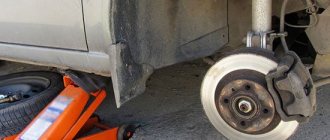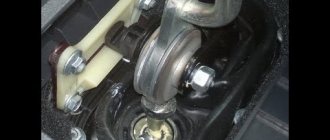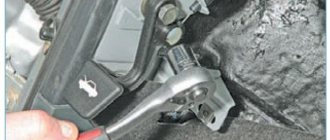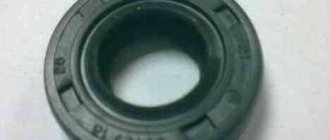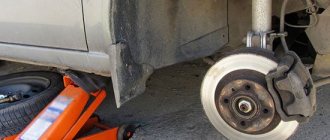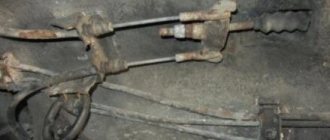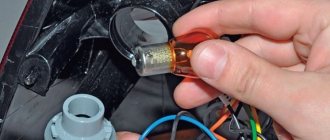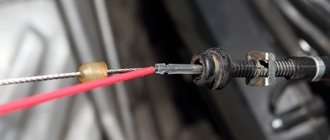Easy replacement of the front suspension arm silent block
When repairing the chassis of front-wheel drive cars of the VAZ family (Samara, Priora, Kalina, Grants), quite often there is a need to replace the silent blocks of the front suspension arms. And if there are usually no problems with replacing the rear hinge of the extension (chamomile), an ordinary hammer and chisel is enough. There are many difficulties with pressing out and pressing in the silent blocks of the lever.
The easiest way is to take the car to a service station, pay the money and not worry about it. But, if you are reading this material, then most likely you will be doing the replacement personally and you want to do everything cheaply, with high quality and without extra effort.
What kind of tricks are not used:
- buy new levers with already pressed silent blocks and daisies (a rather low-budget option);
- they take their removed levers to a service station, where they change the silent blocks with a press;
- grind/buy various pullers;
- They are trying to make a replacement using improvised means.
All options are working and you can use whichever one you consider the most problem-free in your situation.
I’ll tell you about a way to replace the silent blocks of a lever without much expense or effort, but you’ll have to prepare a little. So, in addition to the usual tools, we will need:
- Old front wheel bearing from Samara, Priora, Kalina or Granta. If you have been repairing your car yourself for several years, then most likely you already have it lying around somewhere. If not, then you can ask your neighbors in the garage, friends, and finally, at any car service center. Its cost is close to zero, so it will be given to you without any problems at one service or another.
- Long bolt with nut. Preferably hardened, it will last longer. 15 centimeters long, 12 mm in diameter. There should be as many threads as possible. For our purposes, you can take a cylinder head bolt, classic suspension bolts, or in general any suitable bolts.
- A pair of thick washers with a central hole for our bolt, one with an outer diameter of at least 40 mm, the second with a diameter of up to 30 mm.
- Silicone grease or soap solution (or dishwashing liquid).
I won’t describe how to unscrew the lever from the car, since there are a lot of similar materials. And it doesn’t require any special knowledge or skills. Let's move on directly to replacing the silent blocks themselves.
What is a silent block?
The silent block also has another name - rubber-metal hinge. It consists of 2 combined metal bushings, separated by a durable elastic polyurethane insert.
Its primary task is to dampen vibrations in the connections of parts that occur when the machine moves. Uneven road surfaces, potholes and other obstacles transfer a large amount of shock loads to the car’s suspension. Up to 90% of them are taken over by the silent block.
The car's suspension uses two types of rubber-metal joints for the front and rear wheels. This allows the shock load to be evenly distributed along the entire length of the suspension. Additionally, silent blocks are installed in the mounting elements of the gearbox and engine.
Service life of silent blocks
High-quality silent blocks, provided they are installed correctly, can be used even under the most unfavorable conditions for a long period of time. On average, the service life of this suspension element ranges from 70 to 150 thousand kilometers.
The significant difference in the minimum and maximum period of use is due to the quality of the product. Cheap products made from low-quality material will not be able to withstand heavy loads and will quickly stop working properly.
Often, active use of the machine in poor road conditions plays a significant role in reducing the life of silent blocks. First of all, this is driving on dirt roads or off-road.
How to check the support bearing on a Priora?
Some causes of car malfunction:
- expiration of service life (mileage has exceeded 70 thousand km);
- excess axial loads on the racks (careless driving, accidents);
- moisture and dust getting under the hood.
To do this, do the following: 1. Raise the hood. 2. Find and remove the protective cover of the upper cup of the “support” 3. Start rocking the car body from bottom to top, while keeping your palm on the cup. 4. If you feel a knocking sound with your hand or hear grinding and rattling noises, you probably need to replace the bearing.
Separate support bearing VBF for Priora, Kalina
Kit with upper front support housing
Signs of silent block failure
The poor condition of roads during active use of the car creates additional stress on the suspension. As a result, the silent blocks that take the first blow begin to experience additional stress.
The greatest load falls on the elements of the levers and suspension rods. For preventive purposes, experts recommend checking the performance of silent blocks every 50 thousand kilometers.
This will make it possible to identify possible problems in the suspension at an early stage and correctly replace the silent blocks. Often, if a car has not been subjected to preventive inspection for a long time, critical malfunctions may appear that have a serious impact on the safety of driving the car.
Today, the following signs of silent block failure can be identified:
- When driving, the car “pulls” in one direction;
- Lateral tire wear;
- Violation of the vehicle's directional stability when braking;
- Body vibration when the car moves;
- External changes in the integrity of silent blocks;
- Suspension creaks when the vehicle moves;
- Increasing the “stiffness” of the suspension.
Each of these signs or they together indicate a possible problem in the operation of the silent block. There is no need to ignore them and continue to operate the machine.
Such a disregard for one's own safety can end very badly for the driver and passengers.
Do-it-yourself silent block remover
The VAZ 2107 hinge puller can be purchased ready-made or made by yourself. If you have the right equipment and materials, every car enthusiast can make the tool. It is also worth considering that the quality of purchased devices today leaves much to be desired. You can replace the rubber-metal hinge without special tools, but this will require much more time and effort.
Sequencing
To make a homemade puller you will need the following:
- a piece of water pipe 3 cm long with an internal diameter of 40 mm and an external diameter of 50 mm;
- washer with an outer diameter of at least 50 mm;
- M12 bolt 7 cm long with washers;
- two pieces of pipe 10 cm long and 40 mm in diameter;
- vice;
- hammer;
- lubricant
The puller manufacturing process consists of several stages.
- By striking with a hammer, they ensure that a 40 mm pipe section has an internal diameter of 45 mm, i.e., they try to rivet it. This will allow the lower arm joint to pass freely through the pipe.
In order to drive your car confidently and without accidents, you need to periodically inspect and repair the chassis. Wear of silent blocks affects driving safety, as well as tire wear. To replace damaged hinges, you will need to prepare the necessary tools and perform repairs in accordance with step-by-step instructions.
How to properly replace silent blocks?
If a malfunction of one or a group of silent blocks is detected, you cannot hesitate. The vibration created by the car when moving will not be damped by the rubber suspension elements and will be transferred to other parts that will begin to deteriorate.
Ignoring the cheap operation of replacing a silent block can result in significant material costs. The greatest difficulty associated with replacing these elements is pressing. The operation requires the use of special equipment.
Of course, if the goal is to save money at any cost, you can turn to garage craftsmen who perform pressing of silent blocks using homemade equipment. It must be remembered that the quality of work in this case is very low. A guarantee for work performed is almost never given. All actions are performed at your own peril and risk.
If you need to properly replace silent blocks, it is best to contact specialized automobile repair centers. Specialists will be able to quickly and efficiently perform all operations to replace rubber-metal elements.
The cost of replacing the product consists of the price of the rubber element itself and its pressing. As a rule, the entire operation of replacing silent blocks does not take much time.
Replacement of silent blocks of front levers of VAZ 2110
Some car owners are afraid to replace the silent blocks of the front beam on a VAZ 2110 on their own. But in vain. Contacting a service station entails serious financial costs. Plus, it’s far from a fact that the service station will do your job better than you would have done yourself.
Zapisovka
The only thing is that you may need the help of a car service friend. All service stations have a special puller in their tool arsenal. There is no point in purchasing it, since it is expensive and is rarely needed by a car owner. Some craftsmen even make their own puller using a homemade method. There are many drawings and diagrams according to which it is made. So you can try it if you have free time.
There are two silent blocks in the front beam - in the front upper and front lower arm . The procedure for replacing them is somewhat different from each other, so we will consider the processes separately.
Front upper control arm silent block
Broken
Let us immediately note that it is easier to work with it than with the second element. The entire procedure involves performing several sequential operations.
- Raise the car on a jack and secure it in a stationary position. Turn on the handbrake, put stoppers under the wheels.
- Remove the front wheel.
- Unscrew and remove the support. To do this, you will need to turn the wheel out and hit the bipod with a hammer. It is better to do this through some kind of insert.
- By knocking out the support, you can remove the upper front control arm without serious problems.
- There is a bolt on the side, it is quite long. Unscrew it. Inspect the end play. Most likely, it is quite serious and is easily felt when checking. Therefore, you absolutely correctly decided to change the silent blocks.
- You can remove the silent block with a hammer and chisel. Just don't hit it too hard, or you'll damage other suspension components.
- In some cases, the silent block sits very firmly, so you can’t do without a drill and drilling it. After making the holes, you can safely remove the element.
- Now use the smaller bushing to press the new silent block into place. The part must fit firmly and securely into the socket.
What suspension elements need diagnostics?
So, what needs to be done if there is a knock in the suspension , and we’ll also talk about the reasons for its occurrence. First of all, we need to clarify something... If the suspension rattles, it means this is the result of a malfunction or incorrect operation of any part or chassis mechanism, for example, the following may fail:
- Shock absorber;
- Spring;
- Spherical bearing;
- Lower arm with silent block;
- Upper suspension support with bearings;
- Stabilizer link;
- Stabilizer support;
- Steering rack;
- Tie Rod;
- Steering tips;
- Wheel bearing;
- Steering cardan;
- CV joint (outer joint).
It will not be possible to determine the malfunction by ear, nor will it be possible to find the source of this knocking noise in the front suspension. In order to find the malfunction, it is necessary to carry out a thorough diagnosis.
Important points
- The quality of new silent blocks. This is the main point, since the left silent blocks made of bad rubber can simply tear when pressed, and not to mention how long they will work on the car. I recommend using original silent blocks produced by the BRT (Balakovorezinotekhnika) plant; in fact, they are installed on new cars. How to distinguish an original from a fake can be found on the Internet.
- Chamfer on the lever. On one side of the lever, the hole for the silent block has a more pronounced chamfer. It is from this side that the new silent block must be pressed in.
- Design alignment. When assembling the entire device, you need to pay attention to ensure that everything is on the same axis, without distortions, and that all holes match. In this case, everything will go smoothly and without unnecessary effort.
- Abundant lubrication and rubber and bolt help greatly during replacement. When dry, you can even strip the threads of a bolt or nut, especially if the bolts are not made of hardened steel.
Quote
Visual diagnostics of the front suspension
Before you start checking the suspension parts, you must first inspect all the boots and rubber covers of all the listed parts, as well as: silent blocks, ball joints, front suspension arm, anti-roll bar, steering knuckle, mounting bolts, as well as tie rod ends traction As a rule, a part whose cover is damaged needs to be replaced.
It is also necessary to pay attention to rubber seals ; there should be no mechanical damage on the seals. Particular attention should be paid to those places where the parts are adjacent to the body.
When oil leaks are visible on the shock absorber, these are the very first signs of a malfunction, since they appear much earlier than other symptoms, such as scratches and extraneous sounds when rocking, and it should instantly dampen vibrations, and not sway, as happens with gradual failure. The shock absorber may still work normally for some time, but it will still be better if it is replaced.
Press-fitting instructions
At the initial stage, it is necessary to visually assess whether the new silent block is suitable for a particular case. This condition must not be neglected, so that later it will not be too late. There are often cases when the outer part fits perfectly, but the inner part does not, and vice versa. Once you determine that the parts will fit exactly, you can proceed to the next step. To do this, you should use a vice to help press it correctly. This method is safer and more accurate.
You can also use hammers and sledgehammers, but you need to be more careful and carefully monitor the accuracy of the process.
Thus, you will need to land several hits. If after this the broken silent block is firmly held in the hole, you need to knock it out. For this work, special mandrels are used for pressing silent blocks or two pieces of pipe. The diameter of one of these parts must correspond to the parameters of the outer joint bushing. When knocking out a part, you do not need to worry about damaging it, since it is faulty. This process is carried out with a regular hammer.
After knocking out is completed, the eyelet in which the hinge was located must be cleaned of dust, dirt, and so on. The seat for the new part must be perfectly smooth and even. There should be no mechanical damage or various scratches on it. In addition, there should also be no sharp edges.
After cleaning the seat, its surface must be treated with lubricant. If this is not available, you can use a regular soap solution. A device such as a metal polyurethane bushing must also be lubricated. Having completed the lubrication of the seat, you can begin to clamp the lever in a vice. In this case, it will be necessary to install a silent block perpendicular to it. This work is done as smoothly as possible. The further normal functioning of your machine depends on this.
Next, you will need to choose how to press in the silent block - press it in or drive it in with a sledgehammer. To reproduce this process, you will need metal tubes or mandrels for pressing silent blocks, one of which will need to hold the lever. And the other tube must be leaned against the side to avoid damage to the hinge when working with a vice or hammer.
The main difficulty with this work may be the difficulty of pressing the hinges into their original place. To perform this procedure, I recommend using a special press to press them in and out with the levers, as well as a mandrel for pressing in the silent blocks. You can also use improvised means, such as pieces of pipe and a sledgehammer, but you should be very vigilant and attentive, since this process requires high precision and dexterity so that the result is a whole polyurethane insert.
You can press in silent blocks with your own hands only on the front and rear parts of the suspension. If you need to replace rubber-metal joints in engine or gearbox components, you should contact a specialist. This is necessary precisely because replacing parts in such units is a labor-intensive process. To implement it correctly, you must have repair experience and a good knowledge of the main components of the car's structure. If you lack experience and knowledge, it is better not to test your luck and entrust your car to specialists. Because, in addition to the time spent, you will spend a lot on replacing silent blocks.
Checking the front suspension elements
Sagging (worn springs) have a great influence on the performance of the suspension as a whole, and when the springs are tired, this can be determined quite easily without tricky diagnostics, just carefully inspect the car from all sides and pay attention to the landing of the car, if it has become lower than usual, that is, the springs have already served their purpose and require replacement. When the springs sag, it becomes impossible to correctly adjust the wheel camber.
To check the ball joints, you can check how the lower arms move up and down. This check must be carried out in the inspection hole using a mount. There should be no noticeable play.
When pressing the silent blocks of the lower arms with a mount, there should also be no play, and cracked or squeezed out pieces of rubber are not at all acceptable. It is also worth paying attention to how the rubber peels off from the outer or inner bushing or not.
How to diagnose suspension
The failure of bearings can often be determined by rocking the machine up and down; if they are unusable, they will have play. It is not always possible to determine the torn rubber part in the suspension support without removing the support.
Disassembly of the structure
1. Take the spring tie prepared earlier and install it on the second coil of the spring from above and below as shown in the photo. The second screed is installed on the other side symmetrically to the first. The process of bringing the spring together is carried out as follows - tighten the bolts of the first tie until you feel that the second one begins to move freely on the coils, then tighten it until you remove the load from the previous one. That is, in turn on each side.
2. Take the “22” socket and hexagon and unscrew the fastening nut that secures the strut rod to the support.
3. Remove the limiter (bump stop), support bearing, support, and compression limiter.
4. Replace the old rebound limiter washers with those that came with the Acomi struts. Please note that the bottom one is smaller than the top one.
5. Next, remove the spring cup with rubber damper, compression buffer, spring and boot.
Now it is necessary to carry out a visual inspection of the dismantled rack.
The first test of swinging the rod to the top point demonstrated the cause of the malfunction. The resistance in the upper part of the working area quickly disappeared, after which the piston hit the upper part of the cylinder. As you understand, this was the source of the dull knocks.
What does this lead to in relation to the behavior of a car on the road?
Let's say the front wheel of a car hits an obstacle - a stone or gets into a rut, etc. Or the driver makes a maneuver, brakes, or something else. If the car is moving at low speed, so that the force acting on the wheel from the side of the obstacle is insufficient to cause the internal part of the silent block to shift in the other direction, the car will drive on as if nothing had happened, except perhaps by jumping.
If the force exceeds the critical one, then the direction of the residual deformation will be different, as shown schematically in the figure.
Accordingly, this will lead to a change in the installation angles of this front wheel. Which, naturally, will cause a disturbance in the trajectory of the car. Those. the latter becomes dangerous in operation, prone to uncontrolled changes in the direction of its movement, and every now and then “scours” along the course.
It is typical that such a shift will be uncontrolled and random. And therefore difficult to diagnose. If you try to do a wheel alignment (i.e. adjusting the angles of the front wheels), the results will not be very satisfactory. As is the case when the ball joints are faulty.
So what is next?
Finally, if you continue to use it further without repairing the front suspension, the number and size of cracks in the rubber liner become even larger. As a result, the silent block, firstly, begins to collapse, and, secondly, its tendency to inelastic deformation increases. As a result, a gap appears.
It is clear that in this condition of the silent block it is necessary to replace it immediately. Because in the future, the rubber liner will quickly break, the inner part of the silent block will touch its outer part (the one that is pressed into the front suspension arm). When driving, a distinct knocking noise will be heard, especially when hitting uneven roads.
How to pump up a rack?
In order to bring the front struts into working condition, they need to be bled. This must be done as follows:
- Place the front pillar vertically;
- Smoothly pull the rod to the top point;
- After that, gently press it back.
Do 3-4 such repetitions, and there should be no failures or falls while moving the rod. After pumping the racks, try to keep them in an upright position.
